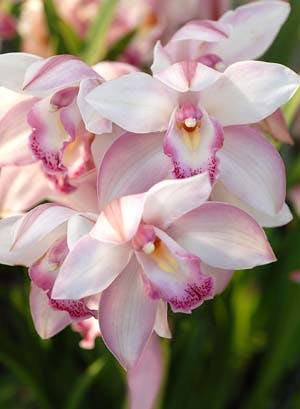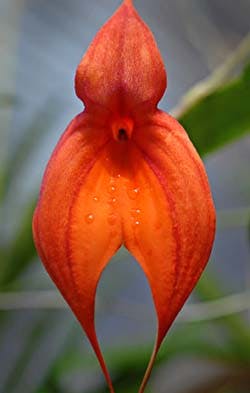Cattleya
Although March is, in many parts of the country, still a cold and blustery month, the lengthening days and warmer temperatures allowed by increased light are long-awaited harbingers of the coming change of season. Some of the best standard cattleyas of the year will be in bloom, or will be blooming soon. The last of the winter-flowering hybrids will join the earliest of the spring hybrids in a wonderful display. Be on the alert for senescing sheaths that need removal. If these yellowing sheaths are not removed, the moisture they trap can lead to bud rot. Careful removal of the sheath will allow the buds to develop, although they will need additional support. Changing light conditions can also be a problem in March and April. An exceptionally bright day, especially immediately following a rain, can lead to sunburn of the foliage if shading is not attended to properly. There can still be periods of dull days where spikes can weakened owing to the lower light. Lengthening days will mean increased metabolic rates necessitating increased water and fertilizer. The plants will indicate needs by drying more rapidly, which means more frequent watering and fertilizing.
With the passing of the season for winter bloomers, and the beginning of the season for spring bloom, it is also the time to be on the lookout for plants that will need potting after they bloom. Immediately after blooming has proven to be the best time to repot winter- and spring-flowering cattleyas. In most cases, they will be ready to grow roots, so if potted at this time, they will root right into fresh mix with little or no setback.

Cymbidium Magic Mountain photographed at Longwood Gardens in early April. © G. Allikas
Cymbidium
Plants should be putting on a spectacular show this time of year. Adjust all staking and twist-ties and be on the lookout for aphids, slugs and snails. Give adequate water because flowering strains the plants. As new growths appear later, increase the nitrogen level in the fertilizer. Should a plant look healthy but not be blooming, try increasing the light during the next growing season. The number-one reason for no flowers is lack of light.
Dendrobium (Australian)
These hard-cane dendrobiums will be at their flowering peak now. It is not unusual to see a specimen of this type in an orchid show boasting 1,000 flowers. The secret with this group -- bred primarily from Dendrobium kingianum and Dendrobium speciosum -- is to provide ample water, fertilizer and light during the growing season.
Lycaste
This genus of superb orchids will be coming to the end of its flowering season. Soon you will see the beginning of new root growth, which is an excellent time to repot into fresh media. As new growth emerges, provide ample fertilizer and water. A sign of good culture is an increase in the size of psuedobulbs with each successive year.
Miltoniopsis
This marks the beginning of the flowering season. Amazing displays of color will dazzle the grower over the next few months. Prepare your plants for optimum display by staking spikes (if needed) and cleaning off the older yellow foliage. Do not miss the wonderful fragrance as the flowers unfold..

Miltoniopsis Martin Orenstein shows off a beautiful waterfall pattern on its labellum. Photographed at Longwood Gardens in early April. © G. Allikas
Paphiopedilum
March is the beginning of the season of heaviest potting for lady's-slipper orchids. However, it is a month where the volume of plants needing attention is still small. It is an excellent month to take the time to work with your paphiopedilums before the pressure of other potting prevents your doing the thorough job you should. Look at each plant: Is it clean of dead and dying foliage? Is it weed free? Does it need potting? Is it in spike? Does it have an insect problem? Cleaning and restaging your paphs is one of the most satisfying tasks of the orchid year. Cleaned and potted paphiopedilums look happy.
The summer-blooming types will be showing the first of their buds in March and April. Be on the lookout for the buds, as well as any insect pests that may have found their way into the crowns of your plants. It is especially difficult to clean mealybugs, in particular, once they have become established in the plant. Better to get to them before they get a good toehold.
Increasing light levels should give emerging spikes the strength they need to grow straight and strong. Do not be too anxious to stake the spikes, because if they are staked too soon, the flowers may develop a "nodding" stance, where the dorsal will not stand upright. If the spikes seem to develop at an angle, let them, and stake after the flower has hardened for best carriage, especially on the hybrids with fairieanum background.
Phalaenopsis
In most of the country, March is the peak blooming month for phalaenopsis. Staking needs to be carefully attended to, so that the flowers will be displayed at their best for orchid shows and judging -- even those intended for your home will look best if properly staked. One of the most decorative aspects of phalaenopsis spikes is the way they gracefully arch. If not staked properly, the spike will lack this grace and will not be as pleasing. Most growers like to have the final support just below the first flower, allowing maximum support, without sacrificing the beauty of the arching spike.
Rapid-growing spikes and open flowers place extra demands on the plant. Careful monitoring of watering and feeding will give the plants the energy they require to give their best floral display. Remember, too, that the lengthening days will also increase the frequency at which plants need water.
Beware of the invasion of sucking pests that accompany the flowering season. Flowers and spikes are favorite targets of mealybugs and scales. Be on the look out for their presence, often indicated by the appearance of sooty mold resulting from the exudate of the bugs, and treat before flowers or buds are too advanced. If flowers and buds are too far along, the chemical treatment may damage or abort them.

Masdevallia Highland Monarch 'Free Spirit' AM/AOS photographed at Parkside Orchids. Ottsville, Pennsylvania © G. Allikas
Pleurothallids
Members in this large and increasingly popular group will be looking their best now. If plants are not in flower, the next few months provide an excellent time to divide if needed or repot into fresh mix. Taking care of these tasks now will allow enough time for your plants to become established before the hot weather arrives.
The AOS thanks Ned Nash and James Rose for this essay.








